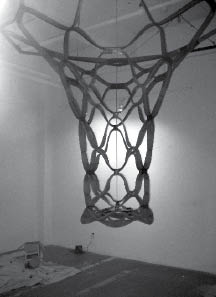What Do You Want, Rubber?
by Albert Chao

World-renowned architect Louis Kahn famously desribed a conversation between a builder and his material: “…you say to Brick, ‘What do you want Brick?’ And Brick says to you ‘I like an Arch.’”
In other words, a material expresses itself through a particular form. On Saturday, September 15 at the Buffalo Arts Studio, Open Columns, the only architectural installation piece in the Beyond/In Western New York biennial, asks, “What do you want, Rubber?”
Led by University at Buffalo Assistant Professor Omar Khan, partner Laura Garofalo and more than 10 undergraduate and graduate students, Open Columns is the first prototype of an ongoing four years of research in composite elastomers, or rubber, as an architectural material, and the possibilities and scenarios that it can create. The installation consists of two skeletal, cyclone-shaped columns, each over 200 pounds, that extend and retract from the ceiling in response to people in the environment. The columns, composed of two colors, a translucent green and an opaque honey, evoke the essence of a breathing beehive.
Rubber is not much used in architecture. Its kinetic components, elasticity and flexibility, have been overlooked for the more static and stable characteristics of materials like wood, metal or brick. Urethane, an engineered form of rubber, is typically used for molds because of its elasticity. The translucent amber soles of Doc Martens are another application of urethane that is durable and flexible.
The first goal of the team’s research was to use rubber’s limitations as possibilities, moving back and forth from material testing to creating complete digital models. Every aspect of the column and rubber had to be engineered, including an adjustable mold made of two-inch-square aluminum rods that traditionally are used as a primary architectural material. “Yo-yo’s,” connection joints that resemble the popular plastic toy, were also fabricated to hold the layers of rubber. Currently, the production of the columns is slow—each requires a month and a half of casting. Further research will seek a better engineered rubber that is more consistent and easier to produce.
The strength of urethane is measured in shore. A higher shore means a stronger but less flexible rubber. A lower shore means a softer but more flexible rubber. Open Columns uses a combination of both. The translucent green urethane located at the top of the columns has a higher shore value for more weight. The column transitions in segments to a honey-colored urethane that has a lower shore for increased flexibility. Each successive layer in between is a combination of both green and honey urethane, which corresponds to the intended form of Open Columns and the ratio of weight to flexibility. The elasticity and flexibility of rubber allows it to extend into space, as Joseph D’Angelo explains: “The column was designed to start from a planar condition and then to extend out and form a column.”
The team created a reactive column that breathes in and out in relation to the number of people, which is measured by a CO2 sensor. The system entices viewers by moving and opens up space by retracting. However, as the number of viewers increases, creating higher CO2 levels, the columns extend to repel and close off space. This simple cycle creates a synthetic existential consciousness. “I did not want to merely index information, as most digital works do, but rather to create a performative and evolving system,” Khan says. “It has rules but no set goal. All it wants is to have a relationship.”
Future applications seem promising. For example, imagine a space that continuously conforms to the number of people in it, the air circulation in different seasons or the lighting throughout the day.
Material research is an important aspect of architecture. Architectural firms today research or appropriate new materials and technology as a part of their practice. The proposed inverted roof of the Darwin Martin House’s Visitor Center is made possible, for example, by the research of the firm Toshiko Mori Architects in woven carbon-fibers. Kennedy and Violich’s research in light-emitting fabrics engages both the tactile and ephemeral nature of the material. Architecture, generally, is considered a slow-moving field, resistant to new technologies. These innovative approaches to material research suggest that is changing.
Open Column will be on exhibition at the Buffalo Arts Studio for the duration of Beyond/In Western New York. Khan also plans to exhibit in New York City in the spring or summer of 2008. Students involved include James Brucz, Gerardo Ciprian, Dirk Pfeifer, Nicole Schlarlau, Si Li, Dennis Cook, Mike Wysochanski, Vail Rooney, Brian Podleski, Brian Clark, Nick Bruscia and Joseph D’Angelo. For more information, visit http://cva.ap.buffalo.edu/.
lectures and exhibitions:
Wednesday, September 17:
Mark Wigley is the current dean of Columbia University’s Graduate School of Archicture, Planning and Preservation. In 1988, Wigley co-curated with Philip Johnson the MoMA exhibition Deconstructivist Architecture, which featured works of Frank Gehry, Zaha Hadid, Peter Eisenman, Daniel Libeskind, Bernard Tschumi, Rem Koolhaas and Coop Himmelb(l)au that related philosophical ideas of Deconstruction to architecture. His lecture is hosted by the University at Buffalo School of Architecture and Planning and will be at 5:30pm on UB South Campus in Crosby Hall Room 301.
Friday, September 21:
Drawing Architecture: The L.J. Cella Collection, opening at the Albright-Knox Art Gallery, focuses on drawing as an important and creative tool for the architect. The exhibition will feature San Francisco Bay Area resident L.J. Cella’s collection of drawings by internationally renowned architects including Vito Acconci, Frank Gehry, Laurence Halprin, Steven Holl, Walter Jean Hood, Robert Irwin, Daniel Libeskind, Richard Neutra and Marjetica Potrc.
Design Matters is presented in association with the UB School of Architecture and Planning.
|
Issue Navigation> Issue Index > v6n37: Northern Lights (9/13/07) > What Do You Want, Rubber? This Week's Issue • Artvoice Daily • Artvoice TV • Events Calendar • Classifieds |









 Current Issue
Current Issue